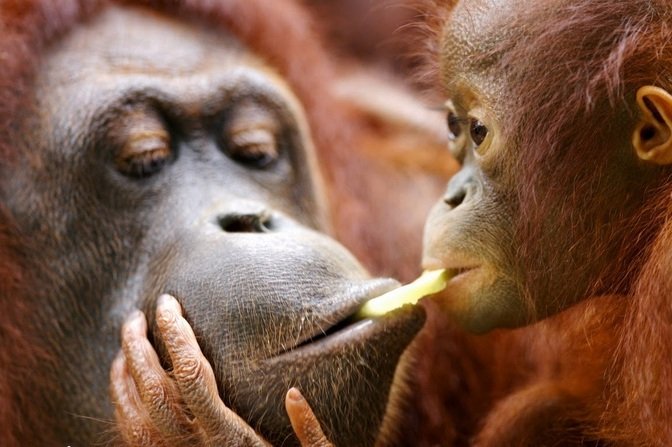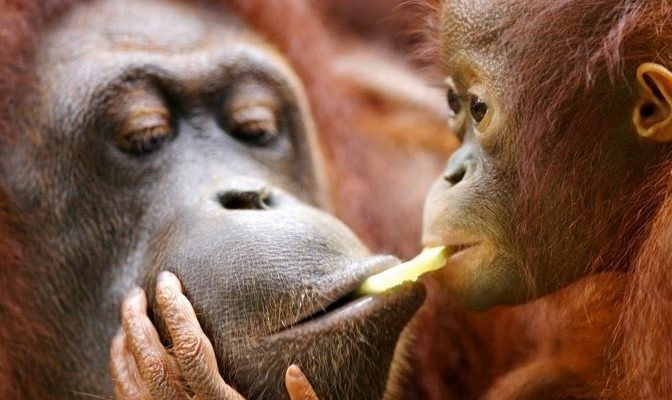
To understand more about their diet, it’s important to note that orangutans are primarily frugivorous, which means they mainly eat fruit. However, their menu isn’t limited to just bananas and berries. Depending on the season and their specific habitat, they’ll indulge in a variety of foods. This flexibility is key to their survival in the wild. Here’s the thing: orangutans are excellent foragers, and their intelligence plays a crucial role in how they hunt for food.
What Do Orangutans Eat?
When it comes to the daily diet of orangutans, fruit is king. However, they have a rather diverse palate. Some of their favorite fruits include:
- Durian: Known as the “king of fruits,” this stinky delight is a favorite among orangutans.
- Figs: These are a go-to snack, especially when other fruits are scarce.
- Rambutan: This tropical fruit is sweet and juicy, perfect for snacking during their foraging adventures.
- Bamboo shoots: While not a fruit, these are a nutritious option that orangutans enjoy.
In addition to fruits, orangutans consume a variety of other foods, including leaves, flowers, seeds, and even the occasional insect. They are known to occasionally eat tree bark and soil, which helps supplement their diet with essential minerals. You might be wondering how they decide what to eat. Well, it often depends on seasonal availability, where certain foods are more abundant at different times of the year.
The Art of Foraging
Foraging for food is more than just a simple snack run for orangutans; it’s an art form. They use their incredible problem-solving skills to find and access food. For example, they may notice which trees have the ripest fruits and strategize on the best way to reach them. Here’s a little story: imagine an orangutan observing a particularly tall tree with a bounty of delicious durians. Instead of recklessly climbing straight up, it might first assess the surroundings, looking for branches and vines to help it navigate the heights safely.
Orangutans also exhibit a technique known as “tool use,” which is quite rare in the animal kingdom. For example, some have been seen using sticks to poke into hollows of trees to extract insects or honey. This clever use of tools showcases their intelligence and adaptability in seeking out food sources. Honestly, it’s pretty impressive to see how thoughtful these creatures are in their foraging techniques.
Seasonal Changes in Diet
Like many animals, orangutans’ diets vary throughout the year, influenced by factors such as climate and food availability. During fruiting seasons, you’ll find them eating copious amounts of fruit, while in leaner months, they may resort to leaves or other less desirable options.
One interesting aspect of their seasonal eating habits is how they adapt to their environment. For instance, during dry seasons when fruit is scarce, orangutans are known to travel further in search of their favorite foods. They might even change their range and explore new territories if it means finding more to eat. This flexibility is pivotal for their survival. Imagine being a foraging expert who knows when and how to pivot in response to nature’s whims; that’s the essence of an orangutan’s dietary strategy.
Social Eating and Interactions
Eating isn’t just about survival for orangutans; it’s also a social activity. You might see a mother orangutan sharing fruit with her young. This sharing behavior helps strengthen their bond and teaches the young ones essential skills for foraging. It’s like a culinary class in the treetops!
Interestingly, orangutans are generally solitary animals. However, when food is plentiful, groups may gather to share the bounty. Imagine a festive feast in the canopy, where everyone is enjoying the fruits of their labor together. This social aspect of their eating habits contributes to their overall well-being and community dynamics.
Strategies for Hunting and Gathering
While orangutans primarily eat fruits that come from trees, their hunting strategies are quite sophisticated. They’re not just grabbing what they find; they strategize extensively. One key method is called “window hunting,” where they patiently observe potential food sources. This gives them a better idea of where the best fruit is and when it’s ripe for the picking.
They also exhibit a behavior known as “suspension feeding.” This technique allows them to hang from branches while they reach for fruits, making it easier to access food without risking a fall. By hanging around and carefully selecting their meal, orangutans demonstrate impressive balance and agility. Picture a gymnast on a balance beam; that’s the level of skill they display while foraging!
Challenges in the Wild
Despite their incredible adaptability, orangutans face numerous challenges in the wild, particularly due to habitat loss and environmental changes. Deforestation for agriculture and logging has severely impacted their food sources, making it harder for them to find what they need to survive.
When their habitats are destroyed, these remarkable creatures often have to travel further to find food, which can lead to increased competition with others. If you think about it, this struggle can be likened to trying to find a parking spot in a crowded city; it’s frustrating and exhausting.
Additionally, climate change is affecting the availability of certain fruits and trees, further complicating their already challenging existence. Without rigorous conservation efforts, the future of orangutans and their intricate hunting and feeding strategies could be at risk.
The diet and hunting strategies of orangutans are a stunning example of nature’s ingenuity. From their frugivorous diet to their clever foraging techniques, these gentle giants showcase a remarkable blend of intelligence and adaptability. Unfortunately, their survival is threatened by habitat loss and climate change, making it all the more important for us to support conservation efforts.
By deepening our understanding of their lifestyle, we not only appreciate these incredible animals more but also foster a sense of responsibility to protect their homes. So, the next time you think of orangutans, remember that every bite they take is a small but vital part of their survival story—one that we can all play a role in continuing.

